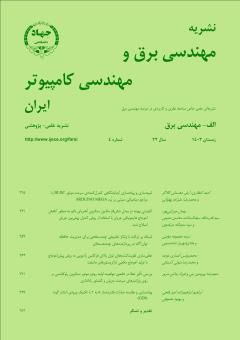خطیسازی تقویتکنندههای توان بالای فرکانس رادیویی (RF) به روش پیشاعوجاج با تولید اعوجاج مکعبی ترانزیستورهای ماسفت
محورهای موضوعی : مهندسی برق و کامپیوتر
محمدیونس انصاری موحد
1
![]() ,
محمدرضا متولی کسمائی
2
,
محمدرضا متولی کسمائی
2
1 - دانشکده فنی و مهندسی، گروه برق، دانشگاه قم، قم، ایران
2 - دانشکده فنی و مهندسی، گروه برق، دانشگاه قم، قم، ایران
کلید واژه: تقویتکننده توان بالای غیرخطی, روش پیشاعوجاج, اعوجاج مرتبه سوم و پنجم, اعوجاج مکعبی,
چکیده مقاله :
در این مقاله به روش پیشاعوجاج و با تولید اعوجاج مکعبی به وسیله ترانزیستور ماسفت، مؤلفه اعوجاج مرتبه سوم (IMD3) و پنجم (IMD5) یک تقویتکننده غیرخطی توان بالای فرکانس رادیویی کاهش مییابد. روش پیشاعوجاج در خطیسازی تقویتکنندههای توان بالای فرکانس رادیویی برای سیستمهای مخابراتی کاربردهای فراوانی دارد. ساختار این روش پیچیده نیست و میتواند به سادگی برای خطیسازی تقویتکنندههای غیرخطی مورد استفاده قرار گیرد. در این روش، اعوجاجی بهعنوان اعوجاج مکمل در ورودی یک تقویتکننده غیرخطی قرار میگیرد تا با جمع دو اعوجاج (یعنی اعوجاج ناشی از خود تقویتکننده غیرخطی و اعوجاج مکمل ناشی از المان غیرخطی دیگر) تقویتکننده غیرخطی را خطی کند. میزان خطیسازی با این روش اگرچه خیلی قابل ملاحظه نیست، اما همین میزان خطیسازی هم برای بسیاری از سیستمهای مخابراتی کافی است. مزیت عمده این روش سادگی مدار، بازدهی بالا و توانایی خطیسازی در یک پهنای باند فرکانسی نسبتاً بزرگ است. در این مقاله مقدار خطیسازی سیگنالهای اعوجاج مرتبه سوم و پنجم تقویتکنندههای توان بالا نسبت به کارهای مشابه قبلی بهتر شده و نتایج به کمک نرمافزار ADS نشان داده شدهاند.
In this paper, the third-order (3IMD) and fifth-order (5IMD) distortion components of a high-power radio frequency nonlinear amplifier are reduced by the predistortion method and by generating cubic distortion using a MOSFET transistor. The predistortion method has many applications in linearizing high-power radio frequency amplifiers for telecommunication systems. The structure of this method is not complicated and can be easily used for linearizing nonlinear amplifiers. In this method, a distortion is placed as a complementary distortion at the input of a nonlinear amplifier to linearize the nonlinear amplifier by adding two distortions (i.e., the distortion caused by the nonlinear amplifier itself and the complementary distortion caused by another nonlinear element). Although the amount of linearization with this method is not very significant, this amount of linearization is sufficient for many telecommunication systems. The main advantage of this method is the simplicity of the circuit, high efficiency, and the ability to linearize over a relatively large frequency bandwidth. In this paper, the linearization value of the third and fifth order distortion signals of high power amplifiers is improved compared to previous similar works, and the results are shown using ADS software.
[1] B. Andžej, V. Barzdenas, and A. Vasjanov, "Linearization as a solution for power amplifier imperfections: a review of methods," Electronics, vol. 10, no. 9, Article ID: 1073, May 2021.
[2] P. L. Gilabert, J. R. Pérez-Cisneros, G. Montoro, M. Lavín, and J. García, "Digital predistortion linearization of a GaN HEMT push-pull power amplifier for cable applications with high fractional bandwidth," IEEE Trans. on Broadcasting, vol. 69, no. 2, pp. 516-527, Jun. 2023.
[3] W. T. Tsai, C. Y. Liou, Z. A. Peng, and S. G. Mao, "Intermodulation distortion analysis for power amplifier with various collector voltages," in Proc. IEEE Int. Symp. on Radio-Frequency Integration Technology, RFIT'18, 3 pp., Melbourne, Australia, 15-17 Aug. 2018.
[4] S. Wang, P. M. Ferreira, and A. Benlarbi-Delai, "Physics informed spiking neural networks: application to digital predistortion for power amplifier linearization," IEEE Access, vol. 11, pp. 48441-48453, 2023.
[5] C. B. Haskins, Diode Predistortion Linearization for Power Amplifier RFICs in Digital Radios, Master Thesis, Virginia Polytechnic Institute and State University, Apr. 2000.
[6] C. S. Cripps, RF Power Amplifiers for Wireless Communications, Artech House, 2006.
[7] J. Pedro and N. Carvalho, Intermodulation Distortion in Microwave and Wireless Circuits, Artech House, 2003.
[8] S. Cripps, RF Power Amplifiers for Wireless Communications, Book, 2nd Edition, Artech, 2006.
[9] Q. Cai, W. Che, and K. Ma, "A linear GaN power amplifier using novel transistor based analog predistortion method," in Proc. IEEE MTT-S Int. Microwave Workshop Series on Advanced Materials and Processes for RF and THz Applications, IMWS-AMP'16, 4 pp., Chengdu, China, 20-22 Jul. 2016.
[10] Q. Cai, W. Che, K. Ma, and M. Zhang, "A simplified transistor based analog predistorter for a GaN Power mplifier," IEEE Trans. on Circuits and Systems II: Express Briefs, vol. 65, no. 3, pp. 326–330, Mar. 2018.
[11] F. G. Minenna, Y. Elskens, and F. Doveil, "The traveling-wave tube in the history of telecommunication", The European Physical Journal H, vol. 44, 36 pp., 2019.
[12] J. Carvers, "Amplifier linearization using a digital predistorter with fast adaptation and low memory requirements," IEEE Trans. on Vehicular Technology, vol. 39, no. 4, pp. 473-382, Nov. 1990.
[13] N. B. Carvalho and J. C. Pedro, Intermodulation Distortion in Microwave and Wireless Circuits, Artech, 2003.
[14] N. Safari, P. Fedorenko, J. S. Kenney, and T. Roste, "Spline-based model for digital predistortion of wide-band signals for high power amplifier linearization," in Proc. IEEE/MTT-S Int. Microwave Symp., pp. 1441-1444, Honolulu, HI, USA, 03-08 Jun. 2007.
[15] M. Xiao, Novel Predistortion Techniques for RF Power Amplifiers, Ph.D. Dissertation Thesis University of Birmingham, Oct. 2009.
[16] P. Kenington, High Linearity RF Amplifier Design, Book, Artech House, 2000.
[17] S. Bhardwaj, S. Moallemi, and J. Kitchen, "A review of hybrid supply modulators in CMOS technologies for envelope tracking PAs," IEEE Trans. on Power Electronics, vol. 38, no. 5, pp. 6036-6062, May 2023.
[18] J. A. G. Aguilar, C. V. Rosales, and E. T. Cuautle, "Automated driving of GaN chireix power amplifier for the digital predistortion linearization," IEEE Trans. on Circuits and Systems II: Express Briefs, vol. 68, no. 6, pp. 1887-1891, Jun. 2021.


